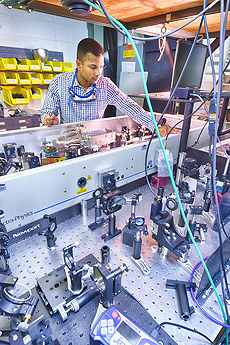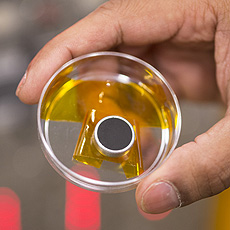Breakthrough: nanotube
cathode creates more electron
beam than large laser system
 |
| Harsha Panunganti of Northern Illinois University works on the laser system (turned off here) normally used to create electron beams from a photocathode.
Photo: Reidar Hahn |
Lasers are cool, except when they're clunky, expensive and delicate.
So a collaboration led by RadiaBeam Technologies, a California-based technology firm actively involved in accelerator R&D, is designing an electron beam source that doesn't need a laser. The team led by Luigi Faillace, a scientist at RadiaBeam, is testing a carbon nanotube cathode — about the size of a nickel — in Fermilab's High-Brightness Electron Source Lab (HBESL) that completely eliminates the need for a room-sized laser system currently used to generate the electron beam.
Fermilab was sought out to test the experimental cathode because of its capability and expertise for handling intense electron beams, one of relatively few labs that can support this project.
Tests have shown that the vastly smaller cathode does a better job than the laser. Philippe Piot, a staff scientist in the Fermilab Accelerator Division and a joint appointee at Northern Illinois University, says tests have produced beam currents a thousand to a million times greater than the one generated with a laser. This remarkable result means that electron beam equipment used in industry may become not only less expensive and more compact, but also more efficient. A laser like the one in HBESL runs close to half a million dollars, Piot said, about hundred times more than RadiaBeam's cathode.
The technology has extensive applications in medical equipment and national security, as an electron beam is a critical component in generating X-rays. And while carbon nanotube cathodes have been studied extensively in academia, Fermilab is the first facility to test the technology within a full-scale setting.
"People have talked about it for years," said Piot, "but what was missing was a partnership between people that have the know-how at a lab, a university and a company."
Piot and Fermilab scientist Charles Thangaraj are partnering with RadiaBeam Technologies staff Luigi Faillace and Josiah Hartzell and Northern Illinois University student Harsha Panuganti and researcher Daniel Mihalcea. A U.S. Department of Energy Small Business Innovation Research grant, a federal endowment designed to bridge the R&D gap between basic research and commercial products, funds the project. The work represents the kind of research that will be enabled in the future at the Illinois Accelerator Research Center — a facility that brings together Fermilab expertise and industry.
The new cathode appears at first glance like a smooth black button, but at the nanoscale it resembles, in Piot's words, "millions of lightning rods."
"When you apply an electric field, the field lines organize themselves around the rods' extremities and enhance the field," Piot said. The electric field at the peaks is so intense that it pulls streams of electrons off the cathode, creating the beam.
Traditionally, lasers strike cathodes in order to eject electrons through photoemission. Those electrons form a beam by piggybacking onto a radio-frequency wave, synchronized to the laser pulses and formed in a resonance cavity. Powerful magnets focus the beam. The tested nanotube cathode requires no laser as it needs only the electric field already generated by the accelerator to siphon the electrons off, a process dubbed field emission.
The intense electric field, though, has been a tremendous liability. Piot said critics thought the cathode "was just going to explode and ruin the electron source, and we would be crying because it would be dead."
One of the first discoveries Piot's team made when they began testing in May was that the cathode did not, in fact, explode and ruin everything. The exceptional strength of carbon nanotubes makes the project feasible.
Still, Piot continues to study ways to optimize the design of the cathode to prevent any smaller, adverse effects that may take place within the beam assembly. Future research also may focus on redesigning an accelerator that natively incorporates the carbon nanotube cathode to avoid any compatibility issues.
—Troy Rummler
 |
| The dark carbon-nanotube-coated area of this field emission cathode is made of millions of nanotubes that function like little lightning rods. At Fermilab's High-Brightness Electron Source Lab, scientists have tested this cathode in the front end of an accelerator, where a strong electric field siphons electrons off the nanotubes to create an intense electron beam.
Photo: Reidar Hahn |
|